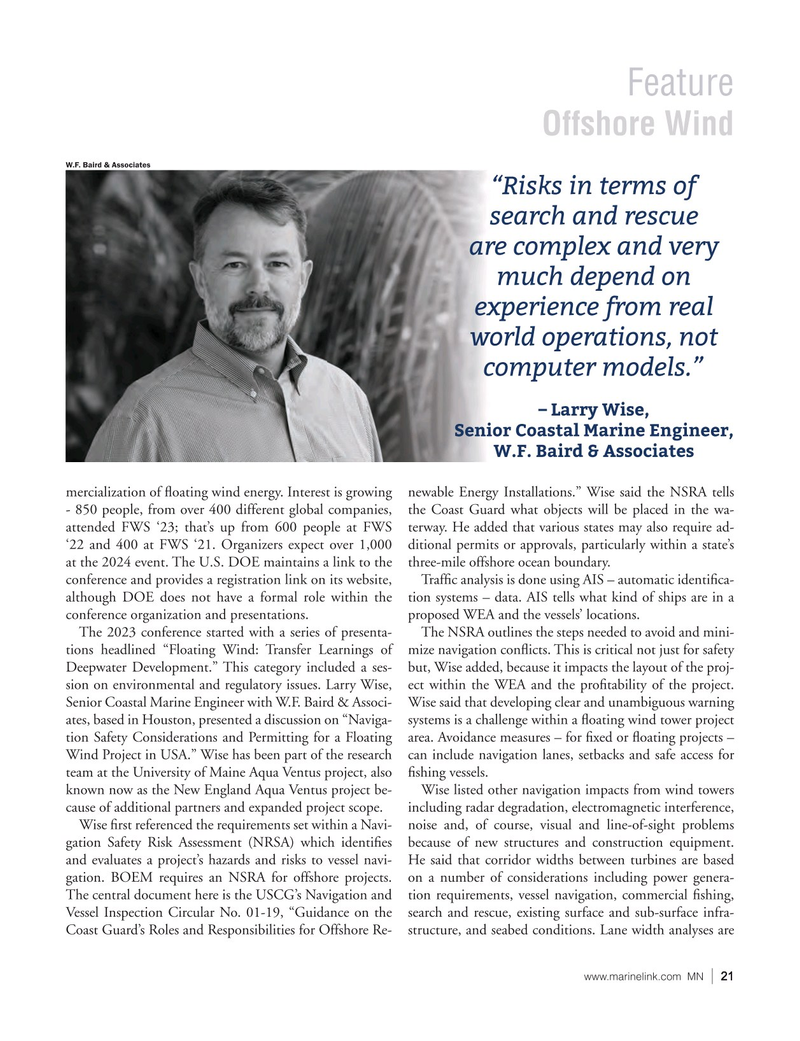
Page 21: of Marine News Magazine (April 2023)
Towboats, Tugs & Barges
Read this page in Pdf, Flash or Html5 edition of April 2023 Marine News Magazine
Feature
Offshore Wind
W.F. Baird & Associates “Risks in terms of search and rescue are complex and very much depend on experience from real world operations, not computer models.” – Larry Wise,
Senior Coastal Marine Engineer,
W.F. Baird & Associates mercialization of ? oating wind energy. Interest is growing newable Energy Installations.” Wise said the NSRA tells - 850 people, from over 400 different global companies, the Coast Guard what objects will be placed in the wa- attended FWS ‘23; that’s up from 600 people at FWS terway. He added that various states may also require ad- ‘22 and 400 at FWS ‘21. Organizers expect over 1,000 ditional permits or approvals, particularly within a state’s at the 2024 event. The U.S. DOE maintains a link to the three-mile offshore ocean boundary.
conference and provides a registration link on its website, Traf? c analysis is done using AIS – automatic identi? ca- although DOE does not have a formal role within the tion systems – data. AIS tells what kind of ships are in a conference organization and presentations. proposed WEA and the vessels’ locations.
The 2023 conference started with a series of presenta- The NSRA outlines the steps needed to avoid and mini- tions headlined “Floating Wind: Transfer Learnings of mize navigation con? icts. This is critical not just for safety
Deepwater Development.” This category included a ses- but, Wise added, because it impacts the layout of the proj- sion on environmental and regulatory issues. Larry Wise, ect within the WEA and the pro? tability of the project.
Senior Coastal Marine Engineer with W.F. Baird & Associ- Wise said that developing clear and unambiguous warning ates, based in Houston, presented a discussion on “Naviga- systems is a challenge within a ? oating wind tower project tion Safety Considerations and Permitting for a Floating area. Avoidance measures – for ? xed or ? oating projects –
Wind Project in USA.” Wise has been part of the research can include navigation lanes, setbacks and safe access for team at the University of Maine Aqua Ventus project, also ? shing vessels.
known now as the New England Aqua Ventus project be- Wise listed other navigation impacts from wind towers cause of additional partners and expanded project scope. including radar degradation, electromagnetic interference,
Wise ? rst referenced the requirements set within a Navi- noise and, of course, visual and line-of-sight problems gation Safety Risk Assessment (NRSA) which identi? es because of new structures and construction equipment. and evaluates a project’s hazards and risks to vessel navi- He said that corridor widths between turbines are based gation. BOEM requires an NSRA for offshore projects. on a number of considerations including power genera-
The central document here is the USCG’s Navigation and tion requirements, vessel navigation, commercial ? shing,
Vessel Inspection Circular No. 01-19, “Guidance on the search and rescue, existing surface and sub-surface infra-
Coast Guard’s Roles and Responsibilities for Offshore Re- structure, and seabed conditions. Lane width analyses are www.marinelink.com MN 21|

 20
20

 22
22
